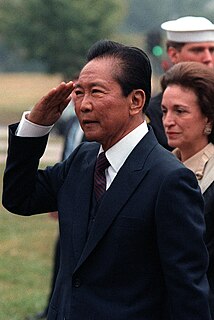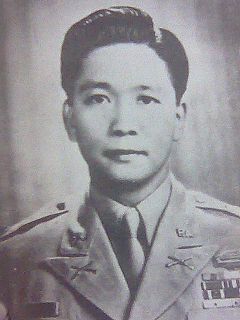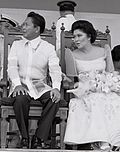
Ferdinand Emmanuel Edralin Marcos Sr. was a Filipino politician, lawyer, dictator, and kleptocrat who was the 10th president of the Philippines from 1965 to 1986. He ruled under martial law from 1972 until 1981 and kept most of his martial law powers until he was deposed in 1986, branding his rule as "constitutional authoritarianism" under his Kilusang Bagong Lipunan. One of the most controversial leaders of the 20th century, Marcos' rule was infamous for its corruption, extravagance, and brutality.

Imelda Romualdez Marcos is a Filipina politician and convicted criminal who was First Lady of the Philippines for 20 years, during which she and her husband Ferdinand Marcos stole billions of pesos from the Filipino people, amassing a personal fortune estimated to have been worth US$5 billion to US$10 billion by the time they were deposed in 1986. By 2018, about $3.6 billion of this had been recovered by the Philippine government, either through compromise deals or sequestration cases.

Ferdinand Romualdez Marcos Jr., commonly referred to as Bongbong Marcos and by the initials BBM, is a Filipino politician who is the president-elect of the Philippines. He previously served as a senator from 2010 to 2016. He is the second child and only son of former president, dictator, and kleptocrat Ferdinand Marcos Sr. and former first lady and convicted criminal Imelda Romualdez Marcos.

Maria Imelda Josefa Remedios "Imee" Romualdez Marcos is a Filipina politician serving as a Senator since 2019. She is the daughter of the late president, dictator and kleptocrat Ferdinand Marcos and former first lady and convicted criminal Imelda Marcos. She previously served as governor of Ilocos Norte from 2010 to 2019 and as representative of Ilocos Norte's 2nd district from 1998 to 2007.

Querube Cortinas Makalintal was the Chief Justice of the Supreme Court of the Philippines from 1973 to 1975 and Speaker of the Interim Batasang Pambansa from 1978 to 1984.

The Ratification Cases, officially titled as Javellana v. Executive Secretary, was a 1973 Supreme Court of the Philippines case that allowed the 1973 Philippine Constitution to come into full force, which led to dictator President Ferdinand Marcos staying in power and ruling by decree until he was ousted by the People Power Revolution in 1986. The decision became the cornerstone of subsequent decisions whenever the validity of the 1973 Constitution was questioned.
Philippine habeas corpus cases are cases decided by the Supreme Court of the Philippines, which invoke the writ of habeas corpus.

Martial law in the Philippines refers to the various historical instances in which the Philippine head of state placed all or part of the country under military control - most prominently during the administration of Ferdinand Marcos, but also during the Philippines’ colonial period, during the second world war, and more recently on the island of Mindanao during the administrations of Gloria Macapagal Arroyo and Rodrigo Duterte. The alternative term "Martial Law Era" as applied to the Philippines is typically used to describe the Marcos martial law period specifically.
It was in the late 1960s and early 1970s that the Philippines saw a surge in student activism. This could be chalked up to the onset of the Marcos administration and its declaration of Martial Law, which bore witness to tens of thousands of human rights violations, among many others. There are, however, several factors and events in Philippine history that contributed to the increase in student activism during this period. In fact, economic decline, increase in unemployment rates, the growth of intra-elite conflicts, and internal dissension and disruption all factored into the context of student activism in the Philippines. It was around this time that businesses in Manila tried to find opportunities to withdraw when the city started to be deemed unsafe. Five Communist oriented guerrillas in the countryside had also regained some of the momentum similar to the Huks had before they were contained by Magsaysay in the 1950s. The coming of a revolution was considered a possibility waiting to happen at one point as riots and demonstrations erupted, causing colleges to be closed down. All of these culminated in an effort to storm the Malacañang.

Batas Militar is a 1997 Filipino television documentary film about martial law under Ferdinand Marcos. The film was directed by Jon Red and Jeannette Ifurung, with the former focusing on dramatizations. It is the most expensive documentary film produced in the Philippines.

The Military career of former Philippine President Ferdinand Marcos during World War II has been the subject of debate and controversy, both in the Philippines and in international military circles. Marcos, who had received ROTC training in the University of the Philippines, was activated for service in the US Armed Forces in the Philippines after the attack on Pearl Harbor. He served as a 3rd lieutenant during the mobilization in the summer and fall of 1941, continuing until April 1942, after which he was taken prisoner. According to Marcos' account, he was released from prison by the Japanese on August 4, 1942, and US military records show that he rejoined USAFIP forces in December 1944. Marcos' military service then formally ended with his discharge as a major in the 14th Infantry, US Armed Forces in the Philippines Northern Luzon, in May 1945.

At 7:17 pm on September 23, 1972, President Ferdinand Marcos announced on television that he had placed the entirety of the Philippines under martial law. This marked the beginning of a 14-year period of one-man rule that would effectively last until Marcos was exiled from the country on February 25, 1986. Even though the formal document proclaiming martial law – Proclamation No. 1081, which was dated September 21, 1972 – was formally lifted on January 17, 1981, Marcos retained essentially all of his powers as dictator until he was ousted.
The dictatorship of Philippine President Ferdinand E. Marcos in the 1970s and 1980s is historically remembered for its record of human rights abuses, particularly targeting political opponents, student activists, journalists, religious workers, farmers, and others who fought against the Marcos dictatorship. Based on the documentation of Amnesty International, Task Force Detainees of the Philippines, and similar human rights monitoring entities, historians believe that the Marcos dictatorship was marked by 3,257 known extrajudicial killings, 35,000 documented tortures, 77 'disappeared', and 70,000 incarcerations.

The Marcos family is a political family in the Philippines. They have established themselves in the country's politics, having established a political dynasty that traces its beginnings to the 1925 election of Mariano Marcos to the Philippine House of Representatives as congressman for the second district of Ilocos Norte; reached its peak during the 21-year rule of Ferdinand Marcos as president of the Philippines that included his 14-year dictatorship beginning with the declaration of Martial Law throughout the country; and continues today with the political careers of Imelda Marcos, Imee Marcos, and Ferdinand Marcos Jr.

Ferdinand Marcos' second term as President of the Philippines began on December 30, 1969, as a result of his winning the 1969 Philippine presidential election nearly two months earlier on November 11, 1969. Marcos was the first and last president of the Third Philippine Republic to win a second full term. The end of Marcos' second term was supposed to be in December 1973, which would also have been the end of his presidency because the 1935 Constitution of the Philippines allowed him to have only two four-year terms. However, Marcos issued Proclamation 1081 in September 1972, placing the entirety of the Philippines under Martial Law and effectively extending his term indefinitely. He would only be removed from the presidency in 1986, as a result of the People Power Revolution.

Ferdinand Marcos developed a cult of personality as a way of remaining President of the Philippines for 21 years, in a way that political scientists have compared to other authoritarian and totalitarian leaders such as Joseph Stalin and Adolf Hitler, but also to more contemporary dictators such as Sukarno and Suharto in Indonesia, Saddam Hussein in Iraq, and the Kim dynasty of North Korea.
The August 24, 1974 military raid on the Sacred Heart Novitiate in the Novaliches district of Quezon City in the Philippines is considered an important turning point in the Philippine Catholic church's resistance to the Marcos dictatorship.

Historical distortion regarding Ferdinand Marcos is a phenomenon in the politics of the Philippines. Ferdinand Marcos was the country's president between 1965 and 1986. Distortion, falsification, or whitewashing of the historical record regarding this period, sometimes referred to using the phrases "historical denialism", "historical negationism", or "historical revisionism" as an eupheminism for negationism, is an academically documented phenomenon linked to the return of Marcos' immediate family and political allies to government positions, as well as the hero's burial of Marcos himself in 2016. It continues Marcos' own efforts to create a cult of personality for himself, which in itself involved various forms of historical distortion.

Primitivo "Tibo" Medrana Mijares was a Filipino journalist, author, war hero, and former press censor and propagandist. He was a reporter of the Philippines Daily Express, a newspaper in circulation during the regime of former Philippine President Ferdinand Marcos.

Journalism during the Marcos dictatorship in the Philippines—a fourteen year period between the declaration of Martial Law in 1972 until the People Power revolution in February 1986—was heavily restricted by Philippine dictator Ferdinand Marcos in order to suppress political opposition and prevent criticism of his administration.














